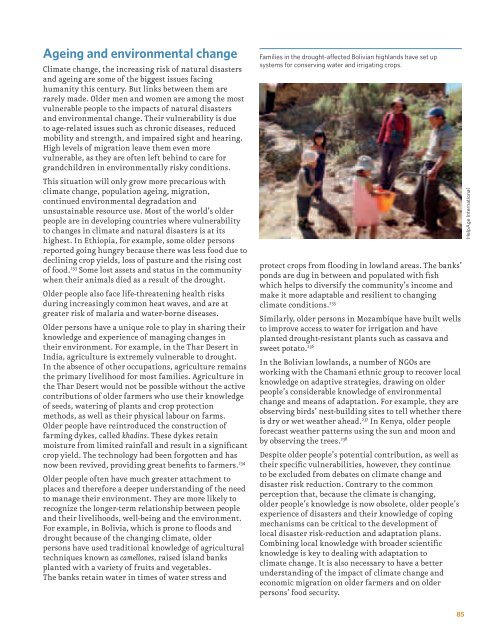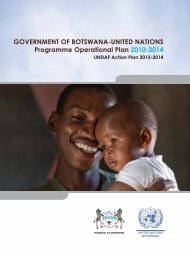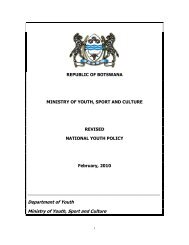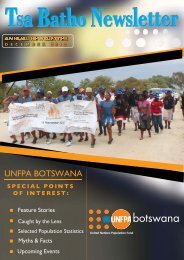Ageing in the Twenty-First Century: - HelpAge International
Ageing in the Twenty-First Century: - HelpAge International
Ageing in the Twenty-First Century: - HelpAge International
Create successful ePaper yourself
Turn your PDF publications into a flip-book with our unique Google optimized e-Paper software.
<strong>Age<strong>in</strong>g</strong> and environmental change<br />
Climate change, <strong>the</strong> <strong>in</strong>creas<strong>in</strong>g risk of natural disasters<br />
and age<strong>in</strong>g are some of <strong>the</strong> biggest issues fac<strong>in</strong>g<br />
humanity this century. But l<strong>in</strong>ks between <strong>the</strong>m are<br />
rarely made. Older men and women are among <strong>the</strong> most<br />
vulnerable people to <strong>the</strong> impacts of natural disasters<br />
and environmental change. Their vulnerability is due<br />
to age-related issues such as chronic diseases, reduced<br />
mobility and strength, and impaired sight and hear<strong>in</strong>g.<br />
High levels of migration leave <strong>the</strong>m even more<br />
vulnerable, as <strong>the</strong>y are often left beh<strong>in</strong>d to care for<br />
grandchildren <strong>in</strong> environmentally risky conditions.<br />
This situation will only grow more precarious with<br />
climate change, population age<strong>in</strong>g, migration,<br />
cont<strong>in</strong>ued environmental degradation and<br />
unsusta<strong>in</strong>able resource use. Most of <strong>the</strong> world’s older<br />
people are <strong>in</strong> develop<strong>in</strong>g countries where vulnerability<br />
to changes <strong>in</strong> climate and natural disasters is at its<br />
highest. In Ethiopia, for example, some older persons<br />
reported go<strong>in</strong>g hungry because <strong>the</strong>re was less food due to<br />
decl<strong>in</strong><strong>in</strong>g crop yields, loss of pasture and <strong>the</strong> ris<strong>in</strong>g cost<br />
of food. 233 Some lost assets and status <strong>in</strong> <strong>the</strong> community<br />
when <strong>the</strong>ir animals died as a result of <strong>the</strong> drought.<br />
Older people also face life-threaten<strong>in</strong>g health risks<br />
dur<strong>in</strong>g <strong>in</strong>creas<strong>in</strong>gly common heat waves, and are at<br />
greater risk of malaria and water-borne diseases.<br />
Older persons have a unique role to play <strong>in</strong> shar<strong>in</strong>g <strong>the</strong>ir<br />
knowledge and experience of manag<strong>in</strong>g changes <strong>in</strong><br />
<strong>the</strong>ir environment. For example, <strong>in</strong> <strong>the</strong> Thar Desert <strong>in</strong><br />
India, agriculture is extremely vulnerable to drought.<br />
In <strong>the</strong> absence of o<strong>the</strong>r occupations, agriculture rema<strong>in</strong>s<br />
<strong>the</strong> primary livelihood for most families. Agriculture <strong>in</strong><br />
<strong>the</strong> Thar Desert would not be possible without <strong>the</strong> active<br />
contributions of older farmers who use <strong>the</strong>ir knowledge<br />
of seeds, water<strong>in</strong>g of plants and crop protection<br />
methods, as well as <strong>the</strong>ir physical labour on farms.<br />
Older people have re<strong>in</strong>troduced <strong>the</strong> construction of<br />
farm<strong>in</strong>g dykes, called khad<strong>in</strong>s. These dykes reta<strong>in</strong><br />
moisture from limited ra<strong>in</strong>fall and result <strong>in</strong> a significant<br />
crop yield. The technology had been forgotten and has<br />
now been revived, provid<strong>in</strong>g great benefits to farmers. 234<br />
Older people often have much greater attachment to<br />
places and <strong>the</strong>refore a deeper understand<strong>in</strong>g of <strong>the</strong> need<br />
to manage <strong>the</strong>ir environment. They are more likely to<br />
recognize <strong>the</strong> longer-term relationship between people<br />
and <strong>the</strong>ir livelihoods, well-be<strong>in</strong>g and <strong>the</strong> environment.<br />
For example, <strong>in</strong> Bolivia, which is prone to floods and<br />
drought because of <strong>the</strong> chang<strong>in</strong>g climate, older<br />
persons have used traditional knowledge of agricultural<br />
techniques known as camellones, raised island banks<br />
planted with a variety of fruits and vegetables.<br />
The banks reta<strong>in</strong> water <strong>in</strong> times of water stress and<br />
Families <strong>in</strong> <strong>the</strong> drought-affected Bolivian highlands have set up<br />
systems for conserv<strong>in</strong>g water and irrigat<strong>in</strong>g crops.<br />
protect crops from flood<strong>in</strong>g <strong>in</strong> lowland areas. The banks’<br />
ponds are dug <strong>in</strong> between and populated with fish<br />
which helps to diversify <strong>the</strong> community’s <strong>in</strong>come and<br />
make it more adaptable and resilient to chang<strong>in</strong>g<br />
climate conditions. 235<br />
Similarly, older persons <strong>in</strong> Mozambique have built wells<br />
to improve access to water for irrigation and have<br />
planted drought-resistant plants such as cassava and<br />
sweet potato. 236<br />
In <strong>the</strong> Bolivian lowlands, a number of NGOs are<br />
work<strong>in</strong>g with <strong>the</strong> Chamani ethnic group to recover local<br />
knowledge on adaptive strategies, draw<strong>in</strong>g on older<br />
people’s considerable knowledge of environmental<br />
change and means of adaptation. For example, <strong>the</strong>y are<br />
observ<strong>in</strong>g birds’ nest-build<strong>in</strong>g sites to tell whe<strong>the</strong>r <strong>the</strong>re<br />
is dry or wet wea<strong>the</strong>r ahead. 237 In Kenya, older people<br />
forecast wea<strong>the</strong>r patterns us<strong>in</strong>g <strong>the</strong> sun and moon and<br />
by observ<strong>in</strong>g <strong>the</strong> trees. 238<br />
Despite older people’s potential contribution, as well as<br />
<strong>the</strong>ir specific vulnerabilities, however, <strong>the</strong>y cont<strong>in</strong>ue<br />
to be excluded from debates on climate change and<br />
disaster risk reduction. Contrary to <strong>the</strong> common<br />
perception that, because <strong>the</strong> climate is chang<strong>in</strong>g,<br />
older people’s knowledge is now obsolete, older people’s<br />
experience of disasters and <strong>the</strong>ir knowledge of cop<strong>in</strong>g<br />
mechanisms can be critical to <strong>the</strong> development of<br />
local disaster risk-reduction and adaptation plans.<br />
Comb<strong>in</strong><strong>in</strong>g local knowledge with broader scientific<br />
knowledge is key to deal<strong>in</strong>g with adaptation to<br />
climate change. It is also necessary to have a better<br />
understand<strong>in</strong>g of <strong>the</strong> impact of climate change and<br />
economic migration on older farmers and on older<br />
persons’ food security.<br />
<strong>HelpAge</strong> <strong>International</strong><br />
85







